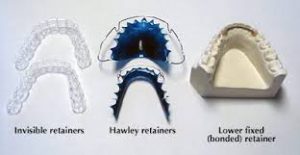Retainers are a very important step in your orthodontic treatment. A retainer is an appliance used to prevent teeth from shifting after completion of orthodontic treatment. Each retainer is custom-made and is always recommended, at least temporarily, upon the removal of braces. No two retainers are the same, even though many look similar. Retainers are very common. In fact, most kids (and adults) who get braces have to wear a retainer for at least a year after getting their braces taken off.
After my braces are removed, will I have to wear a retainer?
Yes. After braces are removed, your teeth can shift out of position if they are not stabilized. A retainer provides that stabilization. A retainer is designed to hold teeth in the corrected, ideal position. Wearing your retainer exactly as instructed is the best insurance that treatment results last a lifetime. As you age, your teeth can shift. The retainer helps to control this shifting, which occurs naturally.
The doctor monitors patients wearing retainers for 1 year upon removal of braces. During that time she will advise about full-time or part-time wear, monitor stability of the teeth, as well as monitor growth and development of wisdom teeth, if appropriate.
Are there different types of retainers?
Yes. Hawley retainers consist of a metal wire affixed to acrylic. These are removable so there are no food restrictions, are durable and are available in a variety of colors. Bonded retainers are fixed retainers glued to the lingual (tongue side) of your front 6 teeth and/or the bottom 6 teeth to ensure that teeth stay as stable as possible. Since bonded retainers are not removable, the same food restrictions will apply as with braces.

Use care when flossing around a bonded retainer to prevent damage. Essix retainers are customized, clear aligners that fit snuggly over your teeth. Oftentimes, the doctor will recommend a bonded retainer, as well as Essix retainers at night. There are several factors the orthodontist will consider when advising you on which retainers will be best including tooth shape and patient compliance.
